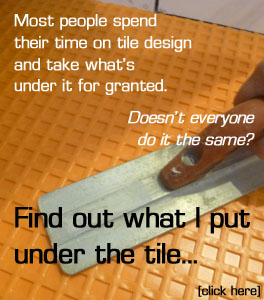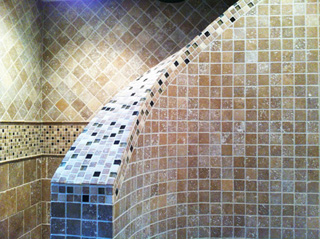 Some projects stand out as being unique, but this one stands alone. It was the largest and most complex shower I’ve ever created and it was a blast to work on. At the core of the design is a wall that not only curves but slopes downward to enclose the shower. One-of-a-kind!
Some projects stand out as being unique, but this one stands alone. It was the largest and most complex shower I’ve ever created and it was a blast to work on. At the core of the design is a wall that not only curves but slopes downward to enclose the shower. One-of-a-kind!
This project had so many parts that I’m going to spread it over several articles. For now, I just wanted to share the highlights.
 The shower is part of a master suite addition to a home in Bloomfield, Indiana (near Bloomington). The idea was to have a shower large enough that didn’t need shower curtain or even a curb. It’s basically a curbless shower, though there is a small 2 1/2″ step into it since the drain was not recessed into the floor.
The shower is part of a master suite addition to a home in Bloomfield, Indiana (near Bloomington). The idea was to have a shower large enough that didn’t need shower curtain or even a curb. It’s basically a curbless shower, though there is a small 2 1/2″ step into it since the drain was not recessed into the floor.
The homeowner picked out the tile and had most of the design in mind. My job was to make it all come together to be the fantastic shower he had envisioned. Most of the tile is from Rush River Studios (at The Tile Shop) and consists of various sizes of natural travertine from the broken cobblestone pieces on the shower floor to the 4″ and 8″ pieces on the walls. The 1″ mosaic includes some glass tiles that make up the decorative band as well as the top of the wall, tying it all together.
The plumbing was installed so that there was room for a tall three-shelf niche centered under the shower head. I used various trim pieces to frame the niche and made the shelves out of larger pieces of travertine. This should provide ample space for storage.
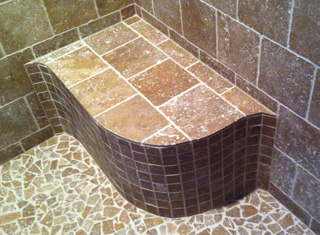 Not only is a wall curved, but the bench was designed with a curved front to match the wall which is just opposite of it. Putting square, flat, tiles on a curve always takes some creativity. In the case of the bench, I was able to cut the tiles for the seat to match the curve and then ‘tumble’ them myself. I actually hit the edge of the tile against another tile until it looked right. Simple, yet profound, right?
Not only is a wall curved, but the bench was designed with a curved front to match the wall which is just opposite of it. Putting square, flat, tiles on a curve always takes some creativity. In the case of the bench, I was able to cut the tiles for the seat to match the curve and then ‘tumble’ them myself. I actually hit the edge of the tile against another tile until it looked right. Simple, yet profound, right?
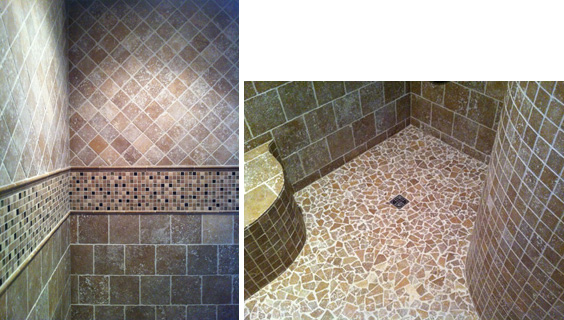 The shower floor was tiled using ‘broken’ pieces of tumbled travertine. These come on mesh backing about 12″ square and actually fit together fairly well. I’m not sure how they do that, but it is really amazing that it looks so random but yet the sheets fit together like they do. I like to fill in some of the larger gaps with small pieces.
The shower floor was tiled using ‘broken’ pieces of tumbled travertine. These come on mesh backing about 12″ square and actually fit together fairly well. I’m not sure how they do that, but it is really amazing that it looks so random but yet the sheets fit together like they do. I like to fill in some of the larger gaps with small pieces.
The entire shower was waterproofed using the Kerdi waterproofing system. Kerdi can be applied to fit any shape or size of shower, which was essential for this shower. The waterproofing extends throughout the bench and niche all the way up to the showerhead to make sure the water goes down the drain where it belongs. The shower was designed to be large enough it doesn’t need a door or a curb. Instead there is just a small step into the shower.
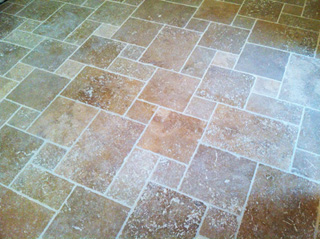 Finally, after tiling the shower I tackled the bathroom floor. After all those curves, it was fairly straightforward! The floor was tiled with a five-piece travertine pattern called Versailles. (Antalya Noce from The Tile Shop) It’s a fairly complicated pattern that mixes the largest 12″ x 18″ tiles with smaller 6″ x 6″ and even some 6″ x 12″ to mix things up a little.
Finally, after tiling the shower I tackled the bathroom floor. After all those curves, it was fairly straightforward! The floor was tiled with a five-piece travertine pattern called Versailles. (Antalya Noce from The Tile Shop) It’s a fairly complicated pattern that mixes the largest 12″ x 18″ tiles with smaller 6″ x 6″ and even some 6″ x 12″ to mix things up a little.
This shower pushed my skills to the limit, but it was so fun to see it all come together.

